Have you ever noticed how ads for kitchen utensils seem to show them arranged as works of art, not tools for cooking? Look at this photo -- three beautifully arranged spoons and one whisk. Nearby a few other miscellaneous items, not all identifiable but all very decorative, and I believe all for sale. Or maybe this is one of the many supposedly helpful illustrations for articles that explain how to have a perfect kitchen by getting more organized and throwing away stuff. For some reason, I have been saving these idealized photos all month. What does this have to do with cooking in real life?
Here are two more reality-challenging photos ...
 |
| I guess the owner of this kitchen threw away all the rest of her tools. |
In real life, who could use a kitchen like these? If you were to hang your utensils above your stove, they would soon be covered with grease even if you had a very fancy hood above the burners. At least they would be greasy if you actually used the stove for cooking.
My real-life utensil storage looks like this:
 |
| If I stored one utensil in each divider space, I would need maybe 100 drawers. I have other drawers but they are worse-looking, so I'll leave them out of the pictures. |
 |
| A real utensil holder. Lots of choices. Nothing matches. In fact, I have two of them with lots of gadgets. Emphasis on usefulness, not on being decorative. |
 |
| Another area where idealism challenges reality: storage of coffee mugs and cookbooks. This photo speaks for itself. No comment on the specialized wine refrigerator and espresso machine. |
 |
| More idealism -- could anyone really manage to keep a mug tree on a working kitchen counter? Maybe she could. |
 |
| A refrigerator organized by a higher power. I won't even include a photo of my fridge here. |
 |
| I use boxes saved from Costco cookies and from Christmas cookies. Also some disposable boxes, old jars, whatever food came in. In real life. |
 |
| A terrible picture of some of my mismatched canisters. Maybe I should spend a few hundred dollars but I would soon drift back. |
I'm sharing this with the once-a-month blogger celebration called "In My Kitchen." Each month, I like to look back on my kitchen stuff and kitchen thoughts, and I look forward to seeing what other bloggers around the world have in their kitchens. Although I enjoy ads, I see them as fantasies. I try to keep a realistic view of what it means to be alive and cooking! To see what other bloggers are sharing, here is Sherry's post with a linkup from other bloggers.
Note: Kitchen advertisements are from Food52, The Container Store, HGTV, and Crate & Barrel.















































